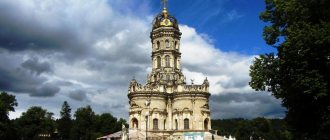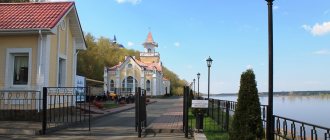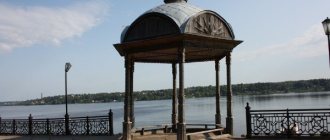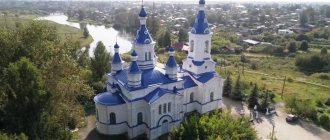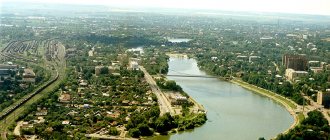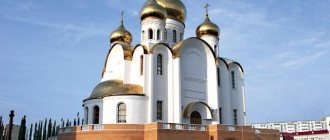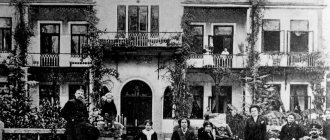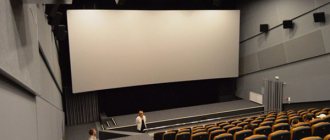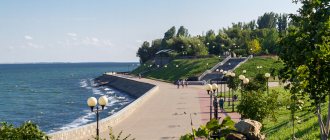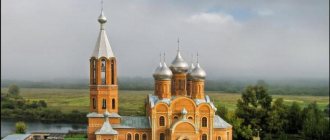I am glad to welcome you, dear readers and subscribers! Volzhsky Boulevard in Kineshma is rich in attractions; this calm, beautiful town on the very bank of the great Volga River will not leave anyone indifferent.
I have lived nearby for many years and love it very much. I would like you to learn more about the city of Kineshma. “Volzhsky Boulevard” in Kineshma is a favorite place for city residents; every corner here is filled with history.
By attending some cultural event or just walking along the river, here you can quietly get acquainted with the House of the Nobility, the Drama Theater named after A.N. Ostrovsky, the monument to Lenin, the Trinity Cathedral, the Tree of Love, the House of the merchant Shemyakin. Each place here is captivating and unique in its own way... but first things first.
How to get to Kineshma from Moscow
By car
Of course, the most convenient way to get there is by car. The drive from Moscow to Kineshma is about 400 km if you choose the route along the M-7 highway through Vladimir and Suzdal. By the way, it turns out to be an excellent road trip to the cities of the Golden Ring - suitable for both short vacations and long holidays (for example, New Year holidays). But let's get back to the main route. The disadvantages of the M-7 route include the advantages listed above. If you do not plan to stop in Suzdal or Vladimir, then you will most likely still be delayed on the road, but due to traffic jams and congestion. Therefore, the route along the Yaroslavl highway (M-8) may be even faster, although 60 km longer. In this case, you need to turn right at Pereslavl-Zalessky onto P74 towards Yuryev-Polsky. You can also stop here to explore the Kremlin; a couple of hours is enough for a city tour.
By public transport
If you travel by public transport, there are two options:
By train 662E
Travel time is 10 hours 20 minutes, departure from Moscow at 22:05 daily. Schedule of ticket prices and route. It’s convenient – I got on the train in the evening, got some sleep, and went straight to the excursion in the morning.
By bus
Travel time is 7 hours or 7 hours 30 minutes. There are two buses every day: at 9:30 and at 12:30. Schedule and prices for bus tickets to Kineshma. Departure from Moscow from Shchelkovsky or Novogireevo bus stations.
Conclusion: the train is a little more expensive (if you take a reserved seat or a compartment), but much more convenient.
Where to stay in Kineshma
First, I’ll tell you where we stopped this time, it’s worth it. The hotel found on the booking site is not just located on the Volga embankment, it literally stands on it. This time we stayed in a boat (no typo). For those who have not yet heard this newfangled word, I’ll tell you. In fact, it is a composite of two English words: boat, (boat, ship, vessel) + hotel.
It turned out to be a boat - a hotel on the water, a former ship rebuilt as a hotel, that is, devoid of ship mechanisms. The boat in Kineshma is called “Peaceful Marina”. The beauty of this particular hotel is not that it is located on the water, although this fact in itself does not play a role; you can’t sail far on this boat.
Another thing is important - you live in the very center of the city and at the same time, as a bonus, you get the opportunity to walk along the embankment and directly from the window or from the deck admire the sunset over the Volga, the sunrise over the Volga, the Volga itself, in general, enjoy the surrounding landscape without any obstacles.
Volzhsky Boulevard Day
Every year in September, Volzhsky Boulevard Day is celebrated in Kineshma, and it is celebrated on a grand scale. On this important day for the city, festive events are held on the embankment.
Below you can see a photo of a huge samovar on the embankment, which on holidays turns into a stall with hot pies and aromatic coffee. Volzhsky Boulevard becomes a festive place where people of all ages enjoy relaxing, because the grandiose holiday unites several generations.
Samovar on Volzhsky Boulevard
People buy souvenirs, listen to performances by musical groups, and participate in various competitions. And in the evening of this day there is a stunning fireworks display over the Volga - a colorful and unforgettable sight!
History of Kineshma
As usual, I will give a short excursion into the history of the city. The first written mention of Kineshma dates back to 1504, when “The Grand Duke of Moscow and the Great Sovereign of White Rus' by God’s Grace” Ivan III came to Kineshma as the inheritance of Prince F.I. Velsky on the occasion of the latter’s marriage to the royal niece Princess of Ryazan. In the late Middle Ages, Kineshma was a fortress, one of the outposts of Russia on the Volga. Rising from the north over the steep bank of the river, the fortress was surrounded by ditches and ramparts, and fortified along the entire perimeter with log walls.
At the beginning of the 17th century, during the period of the Polish-Lithuanian intervention, the citizens and villagers of Kineshma fought desperately with the troops of Pan Lisovsky, but the forces were unequal, and the fortress fell. Later, chapels were erected at the battle sites in memory of the fallen Kinesha residents.
By 1616, Kineshma became the center of the Kineshma district, which included Kineshma, Vichugskaya, Merinovskaya and Vladychenskaya volosts. The city, thanks to its favorable geographical location, conducts extensive trade with other cities of the Volga region, north-west Russia and Moscow. It was inhabited at that time mainly by traders and artisans.
In 1708, Kineshma became part of the Arkhangelsk province, and since 1719 it became part of the Yaroslavl province. In 1777, during the administrative reform, Kineshma was assigned to the Kostroma governorate and became a district town of the Kostroma province. In the second half of the 18th century, crafts actively developed in Kineshma: icon painting, tailoring, blacksmithing, shoemaking, mitten making, as well as the manufacture of wooden utensils, tubs, ladles, shovels and bast shoes. By the end of the 18th century, Kineshma canvases and canvases were sold at local fairs and exported in large quantities to St. Petersburg and Moscow.
With the beginning of the Patriotic War of 1812, the residents of Kineshma formed the Kineshma militia, led by Lieutenant General Bardakov, which became part of Kutuzov’s army.
Kineshma, 1913
In 1871, a railway was built in Kineshma, connecting the city with Moscow. At that time, Kineshma became an industrialized center.
Kineshma: houses of the Nagorskys
A tall wooden tower soars above the blue Volga and colorful Kineshma, as if it wants to break away from its native Spasskaya Mountain and soar even higher. This house knows more about the stars than others: its owner was the luminary of Russian veterinary medicine, Valentin Nagorsky, and there is an observatory tower on the roof, and on the platbands there are faithful solar signs. It is probably only being held by a more unfortunate neighbor under the mountain.
Do not look at Kineshma paintings by artist Kustodiev before traveling to this Volga city. Watch after. So as not to purse your lips near the orphaned merchant houses, not to be sad at the absence of a bright carousel in the square and Pavlovo Posad scarves on the rounded shoulders of ladies. Because the town has lost its colors, but has retained traces of the past, finding and examining which is a special pleasure for those who understand. We advise you to complement your walk in the center with a special attraction of Kineshma – Spasskaya Mountain.
Those coming from Nizhny Novgorod don’t even need to look for anything - Kineshma opens up to us from Spasskaya Mountain. Therefore, as soon as Yuryevetskaya Street makes a bend between two ancient churches and begins to go downhill to the Kineshemka River on the Nikolsky Bridge, we turn onto the patch towards the Nativity Church and park. From the iron staircase of the temple fence, both objects of our interest are clearly visible at once - the stone house and the tower. Their history is closely connected, and their fate is unclear.
This beautiful stone house is located almost close to the roadway. He always attracted the eye with some kind of correctness, simplicity of lines and proportions. Late classicism is like that. You know, like from the drawings in the books of Gogol or Saltykov-Shchedrin. One sad thing is that I only remember him being abandoned. At first it stood with empty windows, then a black banner was strung between the columns based on an old photograph, and the house became even sadder.
It has been up for sale for a long time, but no one is buying it - probably due to its too transity location: there is nowhere to even park, a slope, running streams and probably restrictions on use. The house is increasingly destroyed. And once upon a time he knew other times.
The house was built in 1824 based on an exemplary design from 1809 by the priest of the neighboring Church of the Transfiguration, standing directly above the house, Vasily Melichinsky. Moreover, as historians write, the priest himself drew up the final design of a small mansion in the style of late classicism. Vasily Melichinsky was an extraordinary person: educated and inquisitive, he independently studied architecture and had a unique library, which included handwritten books. His parish consisted of 2.5 thousand people, and a parish school operated at the church.
By the way, I confess that I didn’t take a photo of the temple from a beautiful angle. It is somehow built up on all sides, surrounded by trees. But it is worthy of the attention of even a secular tourist!
Today, the Church of the Transfiguration is the only surviving ancient church in the city, known since the 15th century. And this is the oldest of the stone buildings in Kineshma! A striking example of Kostroma architecture, which is no longer found in modern temple construction. We didn’t go in - the temple was closed, but everything I read about it was amazing.
The original decoration of the temple has not been preserved. On the upper floor, only fragments of the painting remain; the scenes are partially recognizable and the faces of saints are recognizable. These frescoes are very reminiscent to experts of medieval Western European wall painting. For example, in the altar there was a fresco “The Last Supper” (it has not survived to this day; its existence is known only from photographs), surprisingly similar to the painting by Leonardo da Vinci. Another of the scenes, “Christ with a Shovel” (based on the well-known Gospel story), is generally extremely rarely seen today in Russian iconography. This plot is more typical of the Renaissance German and Italian schools. Of course, it does not follow from this that the vaults were painted by Europeans - probably local Kinesha masters, but some of them obviously improved their skills in the capital, where Italians were invited to paint in the 15th-16th centuries.
And then it gets even more interesting. There is information that the house of the priest Melichinsky was inherited by his grandson - also a gifted and outstanding person - Doctor of Medicine, Russian epizootologist, founder of the veterinary system in Russia Valentin Feodoseevich Nagorsky (1845 - 1912). There is practically no information about the family; his memory is not immortalized in Kineshma. Became interesting.
If the grandson does not bear the grandfather’s surname, then he is most likely the son of a daughter, nee Melichinskaya. In addition, the Nagorsky surname, judging by an Internet search, is also a priestly one. The Nagorskys served in the churches of Kostroma, Furmanov, Ivanov, Vichuga, Rodnikov - these are large settlements close to Kineshma. Priestly families willingly became related, however, Fedosy Nagorsky (patronymic name is not found), judging by the information available, did not become a priest, but served as an official in Kineshma. Having been widowed, the mother lived poorly with her son and taught him “with copper money,” that is, with her last pennies. Somehow this doesn’t look like the fate of an heiress or the heir’s mother.
There is little information about the inheritance of his grandfather's mansion - it is only mentioned that Valentin Fedoseevich visited his native Kineshma on visits and stayed. But visiting is not owning, so it is possible that relatives actually owned the house. In addition, there are references that the Nagorskys’ own house was at 5 Nagornaya Street - 140 meters from Melichinsky’s house, if direct.
Taken from arch-heritage.livejournal.com
And if they still live in this house, then my grandfather’s house is open and empty. Here is a photo of the central hall on the first floor - usually guests were received here and evenings were spent, leaving the second floor for private rooms. The ceiling border is intact, the lampshade and stove are missing, some windows are clearly blocked - entirely or from below. And old paint on the ceilings, and previously on the walls. It seems that the walls in the front hall still had expensive silk wallpaper... In Soviet times, this house was home to a club for the deaf society, and during the difficult 1990s, there was a Mercury store.
The back of the house probably overlooked the garden, and not the garbage thicket as it is now. Quiet contemplation or active beautification of the earth with one’s labors - all this was practiced in large families of priests. Now the house is disfigured.
The sign with the agent's phone number is already torn. So the house will collapse, probably without a guardian. Although I could even get a memorial plaque about two wonderful people.
Priest, ethnographer, local historian, teacher, writer, public figure and friend of the Nagorskys Nikolai Nikolaevich Blinov
Well, since we started talking about the priest’s grandson, let’s continue. There is little information, everything was collected bit by bit. Much is from the recorded memories of the Vyatka educator and priest Nikolai Nikolaevich Blinov, who knew Valentin Fedoseevich Nagorsky as a zemstvo doctor.
According to the author’s will, the memoirs were transferred by his daughter Vera Nikolaevna Komarova to the priest Yakov Fedorovich Multanovsky, who was engaged in local history research. At the end of the typewritten text (eleven large format pages) there is an autograph - “St. N.N. Blinov." Now the manuscript is stored in the collections of the local history department of the library named after. A. I. Herzen.
Students of the Imperial Military Medical Academy
“The mother, the widow of an official in the city of Kineshma, could only give her son the opportunity to subsist with meager funds. For example, she herself altered “uniform” clothes for her son from a dress left over from her husband... Remembering his comrades, one veterinarian asked V.F. “if he had trousers in the shape of a milepost.” These were exactly the trousers he had: his mother, in accordance with the “form”, had to sew red piping into “them”, which is why, due to the lack of skill in the work, the trousers twisted on the legs, forming in some way “versts”.
It was not possible to find which educational institution Nagorsky graduated from - it is possible that one of the seminaries - a teacher's or theological one. It was graduates from these institutions who were willing to take exams at the St. Petersburg Medical-Surgical Academy. Pharmacists, doctors of various specialties and veterinarians were trained there. And the uniform did require red piping on the pants.
Nagorsky chose veterinary medicine for himself. According to Blinov, in his third and fourth year at the academy, Valentin Fedoseevich began to earn good money by working every summer in the Novoladozhsky district near St. Petersburg “on the chum” and “Sibirka”, which usually began seasonally with livestock on farms on the canals.
Library separator in a file cabinet. Nagorsky's report.
Having money and gaining independence, Nagorsky got married. Unfortunately, we do not know the exact year of the marriage and its circumstances, including the bride’s maiden name. But it is known that the wife’s name was Evdokia Dmitrievna (1847 – 1934).
Business card of Valentin Fedoseevich’s wife. Private collection. Found on an antique site.
Valentin Fedoseevich Nagorsky
Having received a veterinarian's diploma in 1868, Valentin Fedoseevich moved to the third year of the Medical Academy - this time to become a doctor, which he graduated in 1872. This was the era of Botkin, Sechenov, Ovsyannikov, Junge, Zinin and other luminaries of medicine. By the way, in the same year, 1872, a son, Dmitry (1872 - 1961), was born into the Nagorsky family. Apparently the boy was named after his maternal grandfather.
And then something happened to Nagorsky that later became his distinctive feature among zemstvo leaders - he stood up for the peasants and, as a result, a little later changed the smooth course of his life.
As a fifth-year student, Valentin Fedoseevich took pity on the peasants of the Novoladozhsky district who were starving from lack of food and helped them draw up a petition addressed to the Heir, and they submitted the paper to the Anichkov Palace. A commotion has begun in the upper strata - the peasants are starving near the capital and are already writing complaints! The author of the letter was quickly found. Nagorsky was summoned to the governor, who explained to the medical student that such tricks could get him in Vyatka. A little later, it was the St. Petersburg governor who was especially notified by a graduate of the medical academy, Nagorsky, that it was the Vyatka province that he had chosen as his place of service as a zemstvo doctor. Do you feel the character?
Zemstvo hospital, 19th century
Nikolai Blinov recalls:
“He settled here in the medical district of Oryol district, in the village of Verkhoshizhemskoye. The first thing he needed to do was select and build a zemstvo hospital. Valentin Fedoseevich devoted himself to treating the village population with passion, not sparing his health... As an energetic, knowledgeable and hardworking doctor, Valentin Fedoseevich soon stood out among his comrades. He was invited to serve in the provincial hospital... Under him, congresses of doctors began, sanitary commissions arose, paramedic and obstetric courses were opened...
In 1875, a smallpox epidemic developed in the province... (Nagorsky) for experiments and observations had, for example, to purchase an aspirometer and other instruments at his own expense. He devoted a lot of time to classes at the paramedic school... Valentin Fedoseevich was precisely the person who, according to the conditions of the environment, was a wanderer, an alarm clock, a mover. One contact with him when discussing zemstvo issues already served as a guarantee of a solution in a progressive direction.”
By the way, I would like to separately mention Nagorsky’s wife, Evdokia Dmitrievna. While the smallpox epidemic was raging in the province, another son was born in the family - Nikolai (1876 - 1956). She calmly shared all the difficulties and even became an active helper.
Blinov describes an interesting case. A peasant was admitted to the hospital with a wound or ulcer that did not heal, despite the use of various medical means, and left the patient quite exhausted. Valentin Fedoseevich suggested that if it were possible to sew a piece of living skin into the wound, healing would be ensured. Evdokia Dmitrievna, without hesitation, offered her hand to cut a piece of skin from it. The operation was a success, the peasant began to recover.
By the way, Evdokia Dmitrievna herself was a lady with character. For example, she completely forbade her husband to drink alcohol. Blinov says in his memoirs:
“He... was released late in the evening. Our families drank tea together. In the summer, already at 11 or 12 o’clock we went to the Alexander Garden, walked and sat over the cliff of the Vyatka River. He and I usually lost ourselves in conversation (projects, arguments, etc.). Why did they return home at one in the morning or later, and...drink tea again. Getting tired, Valentin Fedoseevich sometimes needed “reinforcement,” but his wife Evdokia Dmitrievna could not even stand the smell of wine and did not tolerate drinkers.
Sometimes returning from casual practice, V.F. began his speech: “Although scientists recognize the harm of alcohol, Dr. Binz, after lengthy experiments, came to the conclusion that wine is even beneficial in small doses.” During the speech, half a bottle of cognac was gradually removed from his pocket... Binz's theory was applied to tea, no more. "The 'incident' amounted to a joke."
The Nagorskys lived in Vyatka itself for two years and left for St. Petersburg. In the Baltic region at the end of the 1870s, epizootics continued to develop, and the St. Petersburg zemstvo recognized itself in a hopeless situation in the fight against them. Finally, they remembered Nagorsky and offered him a position as a veterinarian. The salary was not important - only 1,200 rubles, but Valentin Fedoseevich agreed. For the sake of his doctoral dissertation, he needed to study at the Medical Academy, in the laboratory of Professor Dobroslavin. In 1880 he defended himself.
In 1883, Nagorsky organized the country's first veterinary bureau under the Moscow provincial government. Having become the head of the Moscow city and zemstvo veterinary medicine, in a fairly short period of time he created and implemented a systematic system of veterinary measures, which caused numerous imitations in other provinces.
He writes in his letter to his friend Blinov in 1886:
“... In Moscow, in terms of work, it’s good, but there is a lack of people with whom you could be in completely sincere relationships, as happened in St. Petersburg with young people when I was young. The same acquaintances that we have now are increasingly of a business nature.”
Employees in the Moscow provincial zemstvo. Nagorsky is specially marked. Photo from a private collection, taken from the website forum.vgd.ru.
The revolution of 1905 alarmed Nagorsky. He wrote in a letter to his friend Blinov: “What, however, will we have? It is impossible to say or guess anything... Alongside the most varied strikes, the most terrible one prevails - the strike of the mind. Only history will give a fair verdict to everything.” But of course he continued to work. Nagorsky is the author of more than 40 scientific papers on medicine, veterinary medicine, as well as veterinary legislation.
Library separator
From 1905 to 1912, Valentin Fedoseevich was the head of the Veterinary Department of the Ministry of Internal Affairs. The Veterinary Directorate of the Ministry of Internal Affairs of the Russian Empire was created in April 1901 in St. Petersburg. It was located at Teatralnaya Square No. 3, partially occupying the building of the conservatory. The head of the department was equivalent to the Director of the department.
Veterinary department in St. Petersburg
While in this position, Nagorsky, for the first time in Russia, drew up veterinary legislation, organized refresher courses for veterinarians, developed rules for keeping livestock and a regulation on the design and maintenance of slaughterhouses, and created a system for combating epidemics and epizootics in Russia. In 1899, 1905 and 1909 he participated in the International Veterinary Congresses. In 1903 and 1910 he was the organizer of the I and II All-Russian Congresses of Veterinarians. Nagorsky lived in St. Petersburg, renting apartment No. 6 on Bolshaya Monetnaya, 16. The address is known from an old business card, although the house no longer exists.
Business card of Doctor of Medicine Nagorsky. The stamp on the image was made by an antique site. Private collection.
Nagorsky loved his job, but in the capital it was impossible to avoid politics - he regularly saved the veterinarians subordinate to him from suspicion of freethinking, which he also wrote about in letters to Blinov. And finally, he did not hide his fatigue from this situation, already complaining about his health. Here is a quote from a letter dated February 1907:
Nagorsky Valentin Fedoseevich
“But besides politics, I found myself in such an inferno of intrigue and abominations that I dreamed of how to get away from this place. Just where will you go? Thanks to the great honor of serving in the zemstvo, I have 22 years left until retirement. I am 62 years old, next, I will live to retire if I live to be 84 years old. Meanwhile, old age is felt, illnesses appear, something wrong happens to the heart. Recently I was ill with influenza, which “grabbed” me by the heart, causing a terribly painful and dangerous attack, almost stopping the activity of the heart. At the last moment before losing consciousness, I managed to tell them to put heating pads on my legs and on the heart area, and this, perhaps, saved me. <…> Now I remember with joy that the remnants of medical knowledge provided me with a service at a critical moment.”
The father’s fatigue and his undisguised “Perhaps I’ll get ready to go on vacation someday!” It was probably taken seriously by the family. Obviously, he was drawn to his native Kineshma. Therefore, son Nikolai Valentinovich Nagorsky in 1907 (according to another version - in 1909) built a wooden tower for his father on Spasskaya Mountain, not far from the Nagorsky family home and above his grandfather’s mansion, and next to the Church of the Transfiguration. You can't think of a better angle. And the views! Here is the dear Kineshma lady with her bell towers, and the Volga with her steamboats, and tea on the veranda, and the stars above the roof.
The house itself was elongated in height, with a ground floor and attic of almost 4 floors in plan along the main facade. Our winter shooting was hardly successful. This shot was taken from the garden of Melichinsky's house. The tower hangs right above him!
This is how it happens with lens masters. Here's someone else's photo with a link to the source. Here you can see that the wooden tower is installed on a brick foundation-base. The log houses of the house and the four-walled base of the tower are stacked “in a paw” (a method of connecting logs in which they do not extend beyond the walls). The joints of the logs are hidden by vertical boards. The house seems quite traditional due to the abundance of the usual Russian hut decor: towels, curtains, skates, valance, saw carvings and solar signs, “crackers” and carved ornaments on the window frames. On the outside, details of the walls, windows, and balcony railings are painted yellow, white, green and blue. The valance of the second floor is decorated with a blue floral pattern. Through these windows the house let the setting sun into the rooms.
Photo from wikimedia.org
The fencing of the second floor balcony, veranda and platform, as well as the observation deck of the tower are flat balusters without patterns or carvings. The “hanging” balconies of the second floor and tower are supported by brackets. The veranda stands on a stone base.
The veranda-gulbische looks towards the temple and the Volga. It was probably intended for relaxation on hot summer days, as it faced the north-eastern side of the house. The windows are enclosed in frames with endings of various shapes and carvings: keel-shaped, gable - a real feast for the eye.
From the street side the tower looks sad. Although it still cannot be denied beauty: asymmetry and some elements somehow subtly hint at modernity.
And this is the southwestern facade - the most beautiful after the main one. For his sake they climbed gullies and deep snowdrifts. Several log buildings and the presence of an observatory tower create a multi-volume effect with an axial vertical offset from the center. At the balcony level the tower becomes octagonal.
The tower, by the way, was a real observatory - it turned, sliding rollers on metal rails, opened the dome, and then Dr. Valentin Fedoseevich truly rested - he studied the stars. The son foresaw everything - astronomy was his father’s outlet. Nagorsky was even a member of the French Astronomical Society.
“One of his extracurricular activities was astronomy. Evoking protests from his family, he opened the window at any time of the year in order to observe or show a guest this or that planet when it fell on a small piece of the sky visible from his apartment,” recalled Comrade Blinov from the St. Petersburg period of his life.
Fedor Alexandrovich Bredikhin
Judging by the memoirs, Dr. Nagorsky was very friendly with the astronomer, professor, director of the observatory of Moscow University and the Pulkovo Observatory Fedor Aleksandrovich Bredikhin (1831 - 1904). Telescopes and everything that can be seen in them in the night sky was the passion of these comrades and, by the way, practically neighbors. Bredikhin's estate was opposite Kineshma, on the other bank of the Volga - in the village of Vladychnoye (now Bredikhino, Zavolzhsk). There the professor rested.
The tower has several porches. Someone describes them as master's and "for servants." But it seems that in the extremely democratic Nagorsky family, the porches were not divided like that. This is the most beautiful thing: the sun under the high tower ridge, a double door with windows.
The tower is like a kaleidoscope that you want to turn and examine in every detail. What a “kokoshnik”, even though the window was mutilated by the crooked installation of a plastic double-glazed window!
The gable roof is complicated by gable ends, alternating in size. “Gothic” roofing ends of chimneys repeat the gable curves of the roof.
And the horses! Maybe Valentin Fedoseevich especially loved them, or is this a tribute to the carved tradition? The joints between the racks and towels with through carvings are decorated with skates.
We didn’t get inside - the house was closed. They climbed through the snowdrifts along the rickety fences that surrounded the mansion.
It is known that inside the floors are united by a two-flight oak staircase with simple turned balusters. The entrance to the tower was through the attic. The internal layout of the rooms has not undergone much changes, but the interior has been almost completely lost: some window frames, doors, heating tiled stoves, and staircases (one spiral leading to the attic) have been preserved. You can see how some glass floats and shimmers with curvature - which means it’s still original, from the beginning of the 20th century.
In the basement of the house there was a kitchen and service rooms. On the ground floor there was a vestibule in the center, and around it there were living rooms - quite a modern solution in the layout with each person allocated their own personal space. Inscriptions on the interior walls of the observatory tower have been preserved: “Moor the dome after classes” and “Close the doors!”
This is one of the most beautiful family nests we have ever seen. It’s a pity that Valentin Fedoseevich could not enjoy these possessions for a long time - intense scientific and social work completely undermined his health.
Fedor Fedorovich Erisman
“Asthma, arteriosclerosis, insufficiency of the semilunar valves of the aorta,” Nagorsky diagnosed himself in a letter to his friend, the famous hygienist Fedor Fedorovich Erisman, who, by the way, from 1865 to 1885 was married to Nizhny Novgorod, the first female doctor in Russia Nadezhda Suslova.
A trip to Italy for treatment turned out to be useless, and on March 29, 1912, Nagorsky died. His body, accompanied by a large number of friends and delegations from various institutions, was transported to his homeland - to the city of Kineshma and buried in the cemetery near the Church of Alexander Nevsky, literally 400 meters from the tower.
Obituary in the magazine “Veterinary Life” dated April 18, 1912
In 1913, Nikolai Nikolaevich Blinov came to his friend’s grave. He was no longer young, but he had traveled a long way to Kineshma. Looking at the mass of wreaths, he noticed the abundance of red flowers...
There is information that after the death of Valentin Fedoseevich, the mansion was inherited by his son Nikolai, and the Nagorsky house was soon sold, as it was expensive to maintain. However, a refutation of this information was found on the Internet - this postcard is from a private collection.
The son, engineer Dmitry Valentinovich Nagorsky, printed on a personalized card from the town of Yamburg (now the city of Kingisepp, Leningrad region) a message from his mother - “To Her Excellency Evdokia Dmitrievna Nagorskaya.” By the way, this appeal applied to persons in the ranks of the 3rd and 4th classes and, accordingly, to their wives, since according to the laws of the Russian Empire, married wives “are ranked according to the ranks of their husbands.” This also applied to widows. The postcard was sent on July 7, 1915 from Yamburg to Kineshma, where it arrived on July 10. This means, at least in the summer, Evdokia Dmitrievna continued to visit the town on the Volga. Three years have passed since my husband's death.
The contents of the postcard deserve special attention. The message is very warm - the adult son Dmitry does not use the usual “father” and “mother” - he continues to write “dear mother” and “dad”. He reports that “everything is fine with us,” which may hint that 43-year-old Dmitry already has his own family. However, he does not sign his family members at the end of the message: perhaps the postcard was a very short, laconic genre. “There’s a lot of work as always” - an engineering position, a military man in 1915 in the yard. Here is a message about the return of a mutual friend from captivity, which somehow especially hurts the eye: the woman was hardly a soldier. Who Mishka and Zelma are remains a mystery, but it is obvious that this mysterious Misha is next to his “dear mother” in Kineshma. But Zelma is some kind of rare oriental name for a lady. In my search, I even came across similar horse and dog names. Could it be a horse or a dog whose health they are interested in? In the family of a veterinarian - quite! And, finally, information that leaves no doubt that these are the same Nagorskys - the mention of the pope, who looked at the stars many years ago with the boy Petrov. By the way, the mentioned Chermoz is not on the shores of the Black Sea, but a town in the Perm region on the banks of the Kama. Great card!
Nifont Ivanovich Dolgopolov
Information was found in open sources that Dmitry Nagorsky’s wife was a Moscow State University researcher, soil scientist Nadezhda Nifontovna Dolgopolova (1893 – 1983). She was the daughter of a well-known surgeon in Nizhny Novgorod, the chief physician of the Babushkinsky Hospital, Nifont Ivanovich Dolgopolov (1857 - 1922) and his wife Vera Fominichna (1861 - 1935), who had the birth name Sheina-Khasya Movshevna Shur.
Nadezhda Nifontovna’s parents were convinced socialists and were subjected to exile, in one of which they met. At the same time, the father was elected to the State Duma, and the mother was the daughter of a Mogilev merchant of the 1st guild. The family lived in an open house, and Nadezhda was the sixth child in the family. It turns out that Dmitry Valentinovich was 21 years older than his wife!
There is also someone’s mention on the Internet that Dmitry Valentinovich had two children - a son and a daughter. However, neither their names nor the years of their life are indicated. The search produces two people: Doctor of Technical Sciences, professor and prominent scientist in the field of electrical equipment of aircraft and automated electric drives Valentin Dmitrievich Nagorsky (1912 - 1991) and radio engineer Vera Dmitrievna Nagorskaya (1913 - 1964).
Could they be the grandchildren of the founder of the veterinary system in Russia? Theoretically, yes. Born in 1912, Valentin Dmitrievich could have received a name in honor of his grandfather Valentin Fedoseevich, who died in the same year. Vera Dmitrievna apparently got her name in honor of her maternal grandmother. And they also had someone to become successful engineers. By the way, in the private collection from which the postcard to Kineshma was taken, there is also an untitled home photograph of a young family from the Nagorsky archives. Perhaps it is Dmitry Valentinovich’s family on it - well, as a version. The shot is amateurish, pre-revolutionary. It is difficult to establish the family resemblance of the intelligent gentleman (except that his close-set eyes give a hint), but the children have a slight age difference, and the mother is noticeably younger than the father. And the tripod behind my back by the window is interesting - it looks like the tripod of a surveyor or engineer.
Unknown. Photo from the Nagorsky family archive. From a private collection. Taken from the website forum.vgd.ru
By the way, in the same private collection there is another photograph, designated “from the Nagorsky archive.” The people depicted on it are also unknown, as is the date of shooting. However, a number of assumptions can be made.
Unknown. Photo from the Nagorsky family archive. From a private collection. Taken from the website forum.vgd.ru
In the photo, apparently, there is a grandmother and grandchildren, who are very similar to each other. The approximate age of the eldest is 7-8 years, the youngest is about 3 years, and the age difference between the Nagorsky sons was just 4 years. That is, the picture could have been taken around 1880, when Dmitry and Nikolai were that age. The Nagorskys, as we remember, had already returned from the Vyatka province and lived in the capitals, where Valentin Fedoseevich defended his doctorate and was preparing for large-scale work in Moscow, or even had already begun it. Moreover, the intelligent gentleman from the previous photo reveals considerable similarities with any of the boys! If we assume that in the home photo it is Dmitry Valentinovich, then in the photo with his grandmother he is the eldest.
An elderly lady - perhaps the mother of Valentin Fedoseevich or Evdokia Dmitrievna. She is dressed in black and is most likely a widow. The hands hint that the lady knew manual labor and did not lead the life of a lady. For 1880, she has a somewhat old-fashioned cap, which was then worn by older ladies.
Well, now let’s look at the photograph’s mat - it’s not well preserved, but the city is clearly Moscow, and a scrap of the master’s name is enough to find him in the list of pre-revolutionary photographic artists. The photo was taken in the popular studio of Pavel Nikolaevich Barbashov - and the PB monogram confirms this. There is a mention that the studio had been operating since 1886, but I think that this is erroneous - there is no this date on the back of Barbashov’s photographs, but medallions with the profiles of current emperors were changed. For example, in a photograph from 1899, the master has a medallion with the profile of Nicholas II and the date of his coronation. The medallions of this passe-partout depict, rather, Alexander II, who reigned until 1881...
In a word, this is the version.
Well, let’s return to the sons of Valentin Fedoseevich Nagorsky. Considering their specialties, it can be assumed that both had a hand in the appearance of the tower: Nikolai (1876 - 1956) was indeed an architect and prepared the project, and Dmitry (1872 - 1961) could design water supply, sewerage and heating - there are memories that he knew how to do this brilliantly. It seems that they did not sell the house to the city, but simply gave it up during the revolutionary year, as many did. It is known that both sons remained in Russia and accepted the new system.
It’s a pity, but there is practically no information about Nikolai, but there is much more about his older brother Dmitry. It is mentioned that he was a mining engineer, a graduate of Moscow University. There is information about him in Yuri Golikov’s memoirs from 1914 about the activities of the Russian Red Cross during the First World War:
“I was the first to attract Dmitry Valentinovich Nagorsky to work in the sanitary and technical bureau. An engineer by training, Dmitry Valentinovich taught at the Polytechnic Institute a course in construction and on equipping buildings with heating, water supply and sewerage. Initiative, active, he was very interested in the introduction of the latest devices and technologies in the heating and sanitary equipment of military hospitals, temporary hospitals and other military sanitary institutions. He willingly traveled to the front-line areas to directly supervise the best arrangement of hospitals. Dmitry Valentinovich was the son of V.F. Nagorsky, one of the organizers of the zemstvo veterinary business in the St. Petersburg province. Based on his first successful experiences in helping to provide water to temporary hospitals, he compiled a manual, which I placed in one of the issues of the “Materials...” of the bureau. The number of requests for assistance in drawing up projects and plans for construction and equipment in the front line and in the rear of hospitals, baths and laundries, and disinfection installations quickly increased. We soon had to attract architects, engineers and other specialists to help Dmitry Valentinovich.”
Even Academician Vladimir Ivanovich Vernadsky himself left memories of Dmitry Valentinovich Nagorsky. Their meeting in Ekaterinodar dates back to December 1919. Vernadsky's entry dated January 8, 1920 states:
“Nagorsky is my student in Moscow, he once studied with me, but was interested in social activities, the son of a famous Zemstvo citizen, the 3rd element in Moscow. (...) He unconsciously gave me the idea to write an article “Living matter and the significance of its study in geochemistry” in English or French (...) pointed out the help that the British or Americans could provide to my work on living matter.”
In the mid-1930s, Dmitry Valentinovich was a professor at the Moscow Higher Technical School. N.E. Bauman, specialty "Metallurgy", Doctor of Technical Sciences. Worked at the Institute of Fossil Fuels of the USSR Academy of Sciences. At the same time, he was also very interested in architecture.
Library separator
Obviously, after the revolution the Nagorskys lived in Moscow. I found them in the list of the most famous and prestigious Moscow necropolis - Novodevichy Cemetery. In its third section, among actors and musicians, heroes and academicians, Evdokia Dmitrievna rested in 1934, architect, candidate of sciences Nikolai Valentinovich - in 1956, doctor of technical sciences, professor Dmitry Valentinovich - in 1961, soil scientist Nadezhda Nifontovna - in 1983 year. There is another burial of the Nagorskys in the same quarter, which most likely confirms the relationship. And this is precisely the radio engineer Vera Dmitrievna Nagorskaya (1913 - 1964).
In 1920, the city receiving radio station was located in the tower. Then there were restoration workshops, a children's art school, a monastery dormitory, and an Orthodox school. Since 1997, the tower has been leased to the parish of the Alexander Nevsky Church. In these caring hands, the house began to look noticeably worse: the fence was rickety, dilapidated elements were not being repaired, plastic windows with ugly streaks of polyurethane foam were installed. The condition of the tower leaves much to be desired. Now the Russian Orthodox Church allegedly plans to turn the house into the residence of the Bishop of Kineshma and Palekh. Surely, the house will not be spared in repairs and will be fenced more securely - it is already almost in the courtyard of the temple. The photo was taken through a closed gate.
It’s a pity, of course, that Kineshma so easily misses the chance to get an excellent “3 in 1” museum - a wooden stylized Art Nouveau, a city estate and the nest of the wonderful Nagorsky family, which gloriously served the Fatherland for several generations. And how many famous people had friendly and professional relationships with their families! Moreover, it would be possible to even get a museum complex - if you make a ladder from the tower down in the house of Vasily Melichinsky’s grandfather... But none of this will happen - so hurry to see what is there.
PS If anyone has information about the people depicted in old photos, we will be glad to find out the details and make changes to the text.
Sights of Kineshma
Today in Kineshma there is little reminiscent of those “golden” times; the city is a typical province for central Russia in the good sense of the word. If the navigator led you to the very center, then, like in any other city in Russia, it will be waiting... In any weather, day or night, this silhouette invariably tells us: here is the city center, here is the street named after me, and here is Sovetskaya.
In fact, the city leaves a very pleasant impression. Yes, there are a lot of dilapidated buildings, yes - the roads are not so hot (and where are they good in our country?). Nevertheless, it’s nice to walk around Kineshma, the embankment is especially nice. The city is quiet and calm, even on the central streets. This is not Plyos or Suzdal, overrun by tourists, this untouched province still remains here.
Volzhsky Boulevard
One of the most beautiful places in Kineshma, loved by both tourists and locals. According to the tradition of the Volga embankments, the boulevard ends with a gazebo.
It is interesting that this tradition has been going on for a long time. You can find a gazebo on the embankment, for example, in photographs of the city taken in 1914.
Trinity-Assumption Cathedral
The boulevard turns into a park, which abuts the ensemble of the Trinity-Assumption Cathedral, consisting of two churches (Trinity 1838, Assumption 1745) and a bell tower, built somewhat later - in 1798. The cathedral is beautiful, but, as always happens with us, the view is spoiled by wires, although no electric transport was noticed in Kineshma.
The Assumption Cathedral remained active for almost the entire Soviet period, preserving ancient church utensils and icons. The main churches that make up the ensemble of the Assumption-Trinity Cathedral are architectural monuments of the 18th-19th centuries. In 1834, Sovereign Emperor Nicholas I visited the Assumption Cathedral. There is an inscription on a column in the cathedral about this important event in the life of the cathedral.
“This holy temple, in 1834, on the 9th day of October, was visited by His Imperial Majesty, Sovereign Emperor Nikolai Pavlovich.”
The construction of Trinity Cathedral was completed in 1838. Built in the spirit of classicism, according to the design of the architect I.E. Efimov, the cathedral became an excellent addition to the temple ensemble. Trinity Cathedral is a century younger than the Assumption Cathedral, and the airiness of its paintings is emphasized by the multi-window dome, thanks to which the entire cathedral seems to be flooded with light.
Since 1866, in connection with the establishment of the Kineshma Vicariate, these cathedrals became cathedrals. On patronal feast days, the bishop serves under their arches.
Next to the cathedrals rises a bell tower - one of the most interesting bell towers in the Ivanovo region, built in a style transitional from Baroque to Classicism. The slender four-tiered structure consists of quadrangles gradually decreasing in plan and is completed with a faceted domed roof with lucarnes, above which two more quadrangles rise, crowned with a vase-shaped dome and a high spire directed into the sky.
The view of the bell tower as a whole on Kineshma is much more interesting from the left bank of the Volga and is a bit reminiscent of the view of the Peter and Paul Fortress in St. Petersburg.
Ensemble of Ascension Churches
Another very interesting attraction is the ensemble of Ascension churches, consisting of the Temple of the Ascension of the Lord and the Chrysostom Church.
This ensemble was erected in the second half of the 18th century on the site of the Widow's Monastery, founded in honor of the events of 1609 (the struggle of the Kineshem people against the Polish-Lithuanian intervention). The Church of St. John Chrysostom is an original monument, combining the forms of pre-Petrine architecture and the Baroque style of the 18th century. The Church of the Ascension is a monumental building with a rare appearance for the last quarter of the 18th century. commitment to ancient Russian forms in their laconic interpretation.
Architecture of Kineshma
Apart from churches and cathedrals, there are no famous attractions in the city. However, the central part of the city attracts with low-rise buildings of the 19th century. There are practically no new buildings here, with the exception of the above-mentioned Ilyich and the Drama Theater named after A.M. Ostrovsky.
Thus ended our trip to Kineshma. In three days we managed to see Suzdal, Plyos and Kineshma, and if not for the rainy weather, we would have seen much more.
Share link:
- Click to share on Twitter (Opens in new window)
- Click here to share content on Facebook. (Opens in a new window)
Article updated:16/01/19
Attractions in the surrounding area
Church of the Life-Giving Trinity in Šileksha
Coordinates: 57.176846, 42.530285 Address: s. Shileksha How to get there: from Kineshma by private car or bus 46 km (1 hour)
The village of Shileksha appeared in these parts thanks to the construction of the Ferapont Monastery in the 14th-15th centuries. There is a legend that the place was donated by the prince to the Tatar prince Shileksha, who came to the service of Russia. The temple was wooden then.
Later, a stone replacement was built, and the Church of the Life-Giving Trinity appeared nearby in 1800. Money for the construction of the latter was donated by the merchant Fedot Syrenkov.
In 1940, the Trinity Church was closed and a bakery was located in it. After which it was abandoned and destroyed. Today the church is not active.
